Dear Creative Soul,
This afternoon my house smells of chai tea, roasted pumpkin soup and almond chicken biriyani. And fresh air. The windows are wide open, the sheets are on the line and the sky is bright and blue. It is the first of October, the beginning of the Noongar season of Kambarang (October-November), the warm and dry. The beginning of the events season at my day job. The beginning of a season where my creative time will be limited and I will have to ensure I do what I need to fill my cup. Small things, like painting and reading and sewing. Today, a day off because I’m working on the weekend, I have been musing about the busy weeks ahead, and how I will find ways to live slowly. And I have finally found time to write about our recent micro-adventure to Mount Barker, a spontaneous (for us) decision to get away from the ‘burbs.
A road trip down south
Friday comes and we set off on our road trip down south, leaving behind suburban edgelands, passing through flat, still green pastures, heading for the hills. The road leading over the Darling Scarp undulates over fertile hills then gives way to forest. This is Jarrah country: towering trees with dark grey fibrous bark and sparse crowns. Crunchy lateritic soils and granite outcrops. I know from A’s love of this tree, that Jarrah (Noongar: Djarraly) can reach more than 40m high; they can also present as a smaller woodland tree. This time of year they bear small white flowers, but we can’t see them from the car, only the bright yellow splodges of hibertia and wattle flowers, the occasional blue Lechenaultia on the side of the road.
As we pass through the historic town of Jarrahdale, past turn offs for hiking trails, I feel A’s longing - this place is part of him, and we have not walked here for months. Last time we walked here, we left saddened by the inescapable evidence of mass plant death in this part of the world. Now, although winter rains appear to have brought much-needed healing and growth, the evidence of loss remains in the was too late for many trees and shrubs. I reach for his hand, squeeze it. We drive on and soon the Jarrah forest alternates with Wandoo woodland before the rolling hills and green, green pasture returns.
And then suddenly, all is gold.
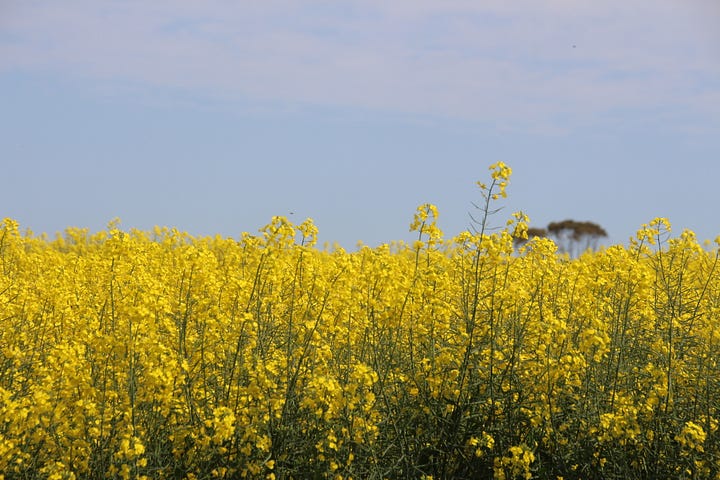


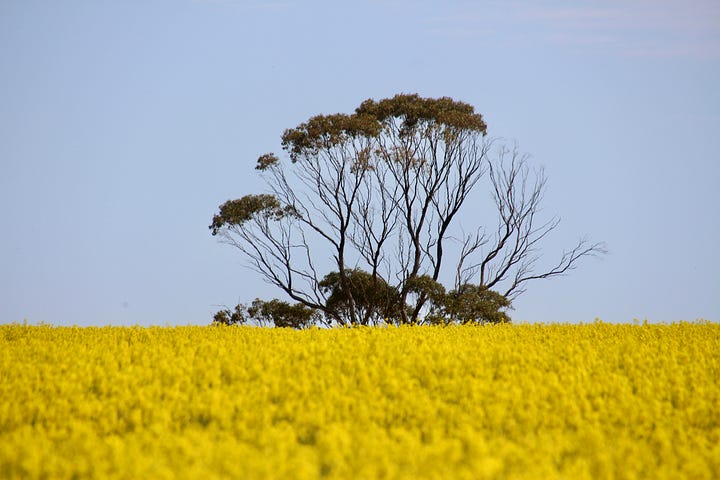
Canola (rapeseed) is Australia’s major oilseed crop and Western Australia's third largest crop behind wheat and barley. Around York, around 160km north of where we have stopped in Arthur River, canola fields have been specifically planted for visitors to walk through (hello Instagram), but everywhere else it is illegal to enter canola fields due to biohazard risks and spraying (and snakes). We don’t need to enter a field to get photos - instead, we wander through the tiny graveyard of church bordering a field right beside the highway and gaze into a golden infinity.
“I never made promises lightly
And there have been some that I've broken
But I swear in the days still left
We'll walk in fields of gold.” - Sting, “Fields of Gold”
A woman in her seventies, maybe eighties, approaches us - her parents are buried here and she has stopped to add flowers to their graves. She is keen to talk - about her childhood growing up in this tiny outpost, about dances that brought people from all over the region, about her love of wildflowers and orchids and the protea she planted in the cemetery last year. Meeting people and hearing their stories is one of my favourite parts of travelling. Random encounters such as this offer a freedom from expectations by skipping the small talk and offering sometimes deep, usually fleeting connections through mutual curiosity. We part with smiles, stories, and a list of wildflower hotspots to visit - she heads north in her camper van, we continue south.
We drive on, through this patchwork of green and gold, through small country towns, feeling a growing sense of anticipation. Any moment now, we will catch a glimpse of the magnificent Stirling Ranges (Koikyennuruff) and then we do, and we are like two children, pointing, exclaiming there they are. The Stirling Ranges, believed to have originated from an ancient sea, is one of Western Australia’s few mountain wildernesses - by world standards, these mountains are not massive (the tallest peak Bluff Knoll stands at 1059 metres above sea level), but to us, it evokes a feeling hard to put into words. Nostalgic, because we climbed this peak seven years ago, but also overwhelming awe. Wonder. It’s almost … spiritual. The glimpse of the far-off blue range brings a catch to my throat - but we drive on, for we are not here to climb mountains this weekend.
We are retreating for rest.

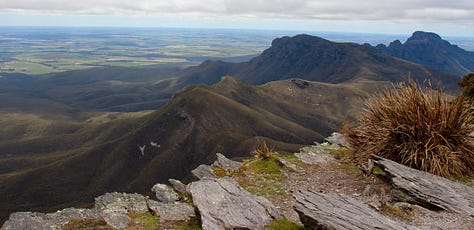
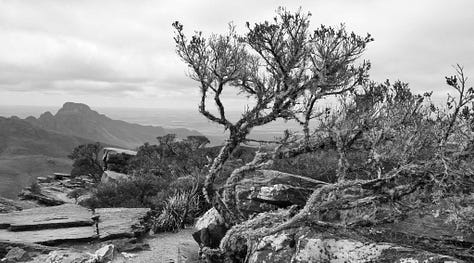
A few kilometres before we reach Mount Barker, we stop for a wine tasting at Gilbert Wines and choose two bottles to take away: an elegant and lightly oaked chardonnay and a reserve shiraz, complex with warm notes of baking spice. (Sadly, the shiraz doesn’t make it home - the bag fell over at our accommodation and the bottle smashed.) We stop in Mount Barker for supplies - the Great Southern region is known for its diverse and exceptional food and wine produce and we load up. Later we will watch the sun set over a fallow vineyard; we will drink another shiraz, eat soft local cheese and listen to birds, sheep, cows, the wind. Now, we make one more stop at the town’s popular bakery for an award-winning pie - Himalayan Herby Chicken for me and Pepper Steak for A. And then we drive out of town, past Mount Barker Hill (Noongar: Pwakkenbak), a registered Aboriginal Heritage Site - long ago, the Noongar people held corroborees where the broadcast tower now stands. Tomorrow we will visit the lookout and stand in misty rain while taking in 360-degree views: the wind farm, the undulating ridges of the Stirling Range to the east, the western ridge of the Porongurup Range, expansive quilt of lowlands stretching to the south coast. But today, we pass it by and drive the last few kilometres, past farms and ruins of old sheds, to our base for the next two nights.


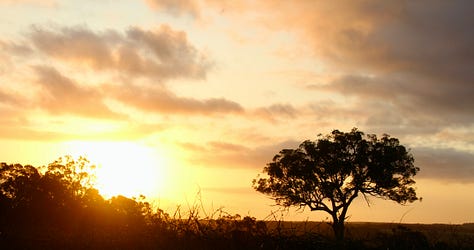
We find our accommodation down a long gravel driveway - we are staying in a converted shed on a working farm. Later, after we unpack, we walk around the still dormant vineyard; past chickens, cows, sheep. The sheep skedaddle, but the cows are curious - we are mystified by their apparent lack of fear as they come closer and closer to the fence, staying just out of arms’ reach. The owner will later tell us that last year they were unable to harvest their grapes - a combination of increasing costs and not-enough available labour that is forcing many smaller vineyards to turn to other land uses - and so they let the cows roam among the loaded vines. It seems the cows have long memories and a lot of hope, for they make indignant sounds when we leave the gate as we found it - locked. In another field is George the alpaca, who stares balefully as if daring us to come near his mate and cria. We walk down a dirt road as the late afternoon wind blows coolly around us, reaching under our too-thin layers, and there are mountains again. Different mountains - the Porongurup Range. There’s that feeling again, but it’s coupled with a wanting, with a yearning, to be closer.
Yearning
Our drive was peppered with our longest-running conversation (apart from our kids), our biggest questions: When will we move to the country? When will we stop thinking of being there for everyone else and let ourselves try what’s been on our heart for so long? When will we stop finding a reason to wait a bit longer? In the days before we left two houses have come up for sale in Bridgetown - they tick several boxes, including price and downsizing. But buying and selling now is difficult. We could sell fast, very fast. But there’s no guarantee we’d get the house we want, even in the country, because the market isn’t working like that now - sellers consider multiple offers and the offers come in thick and fast. Where would that leave us? There are very few rentals, so the timing is critical. And even then … we love the home we have created, the garden that brings in food, birds, bees, butterflies. We have told ourselves we will be happy to just visit down south every once in a while. We tell ourselves every time this comes up. Now, as we gaze towards the soft mountains, wishing we’d brought our heavier coats, our minds are whirling. Why are we so drawn to the south, to hills and mountains? Why can’t we let it go?
Answering the call
It is misty in the morning. Cool, not cold. Sitting on the porch with a cup of tea, I see a fox skulk across the vineyard. It stops and looks right at me, then, tail down, it moves on. We drive to the lookout, then into town for coffee, and decide whether to stick to the original plan of wildflowers and wineries, or heading to the Porongurup National Park for a short walk. We choose the walk, but we know it chose us. It was always going to happen. The mountains’ magnetism is too much for us to resist this time and it has been too long since our last visit. I know this because my eyes well up when the Porongurups, the oldest mountain range in Australia, loom on the road ahead; I am inexplicably emotional, almost overcome. I don’t know why, but maybe I do. There’s something about the wild beauty of the towering granite peaks, the majestic stands of karri trees on the roadside that I can’t understand. The same thing happens to me when I visit the Blue Mountains in New South Wales, my childhood playground. Perhaps it’s the reminder that mountains are so much bigger, so much more powerful, deeper and omnipresent than ourselves. Perhaps it’s the reminder that we are part of nature rather than nature being something we visit.
There’s a sense of familiarity as we drive through the tiny Porongurup town, a place of tourist parks and a lone cafe, with boutique wineries scattered along the scenic drive. We turn off towards the National Park and park, excited and eager; the ranges are known for their high flora species diversity, and are home to over 700 plant species, including 10 endemic species, as well as many mammal or bird species. A suggests we do a section of the Wansbrough Walk, an eight kilometre return hike through Karri forest along a gully between Nancy’s Peak and Devil’s Slide. It is overcast and cool, lending the forest a grey-green tint. I stop to hug a towering old Karri with a mossy skirt - I like to think that I felt something deep within her trunk, but I’m not sure if I did or I imagined it. The Karri survives because of run-off from the granite formations in this area; for me, these smooth-barked trees are among my favourites, especially when they are wet. I would be devastated if they were lost. We continue along the track, which has a gentle gradient, listening to birds we can’t name, looking for fungi and flowers. We pass a running stream and see glimpses of the Devil’s Slide formation, and then reach the turning point. We do not plan to turn right (Devil’s Slide) or left (Nancy’s Peak), but to go straight ahead - we have hiking boots on and a camera slung over my shoulder, but that’s it.
We turn right.
The first part of the trail climbs over exposed granite, before thrusting us into dense, bushy undergrowth on a thin, steep trail. We puff and pant as we follow the trail upwards and upwards, wondering aloud if it will ever end. There are moss-covered boulders, tricky wet slabs of rock to navigate, jagged branches to duck under and around, twisty vines creeping across the path and into deep thickets of bush. There is the occasional wildflower; when stopping to tighten my boots, I find tiny snail orchids. Later, I find a jug orchid, proud and beautiful. We stop often, we wonder why we did this without packing lunch, we keep pushing on. And then we reach the exposed rocky summit area and clamber to the top of Marmabup Rock, the highest peak of the Porongurup Range, all hard bulbous granite. A shower is coming but there is just enough time to marvel at the sweeping views: the rest of the Porongurup Range, a panoramic shot across canola-streaked fields to the Stirling Range in the north, the ocean to the south. We shelter from the rain, and I find more orchids, and, back on the summit, we close our eyes and breathe in the mountainous air. We breathe in gratitude. We breathe in life.
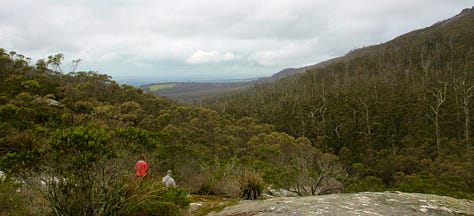
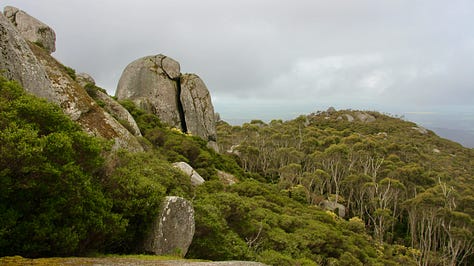
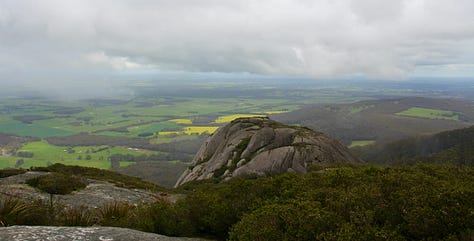


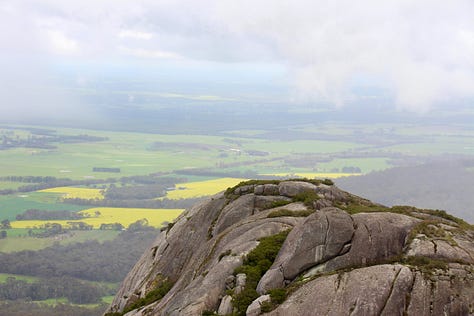
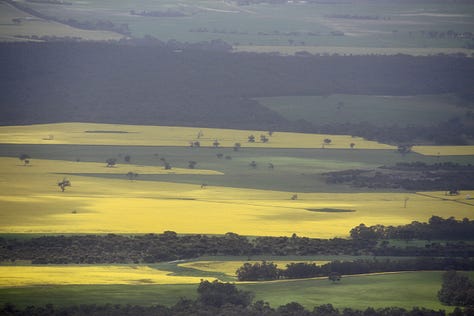
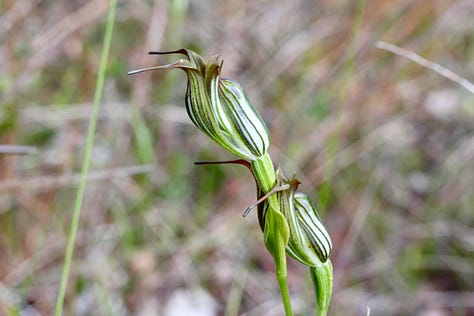
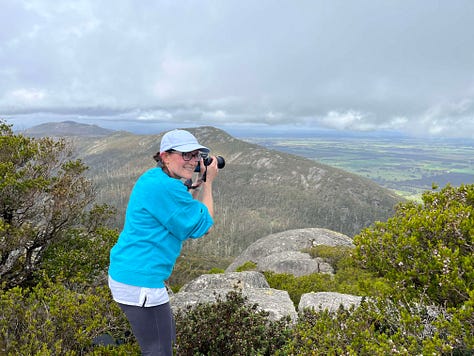
And then we do the long scramble down and walk back to our car. Hungry, tired, fulfilled. We eat burgers at the only place that’s open and drive back to Mount Barker. But we’re not finished yet. We stop at West Cape Howe for coffee and another wine-tasting; we leave with more wine to take home. Back at our accommodation, we take time out; A reads and I paint. Later, we make a grazing board of cheese, crackers, fruit, cold meats and olives and light the fire pit. The farm dogs come to say hello. We sit, dogs at our feet, blankets on our shoulders, wine glasses in hand, and watch the sun set, lost in our own musings. We have no answers to our questions - nor will we when we detour to Bridgetown to check out the two houses that piqued our interest - but we are, in this moment, content.
La Muse: Pausing to Wonder is a gift of words and will continue to be free for all readers for the foreseeable future. However, if you feel led (and able) to support my writing financially, there are a couple of options: 1) Buy Me a Coffee, which is a one-time “tip” as a way to say thank you, or 2) subscribe at one of my paid tiers if you wish to provide ongoing support. You can also recommend my Substack to other readers or buy my book.
Either way, I am grateful that you have chosen to be here today, to be part of my community of readers and writers pausing to wonder (and wander). Let's keep connecting as a community and building each other up.

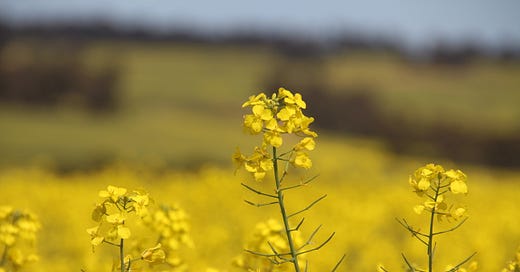





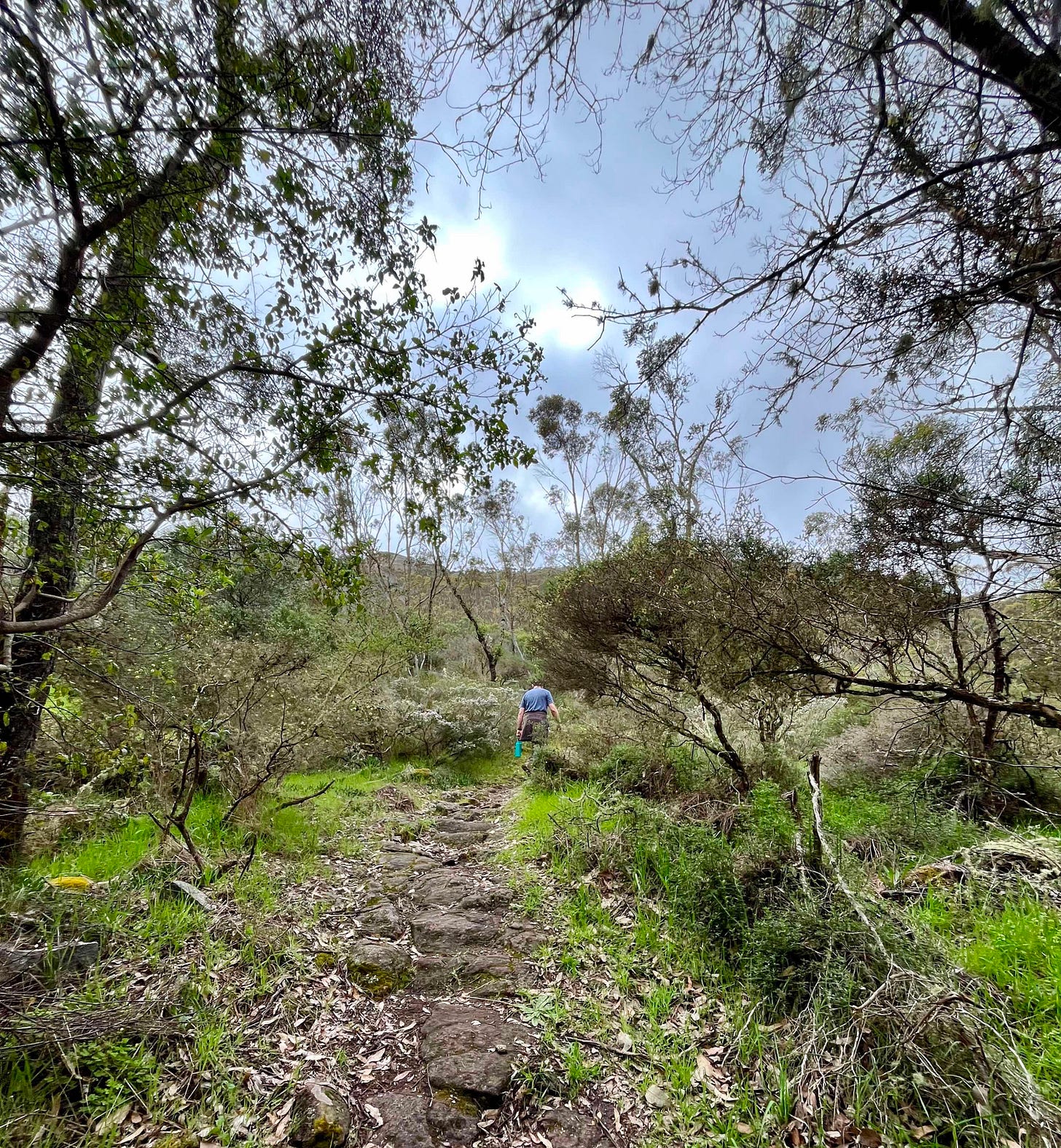
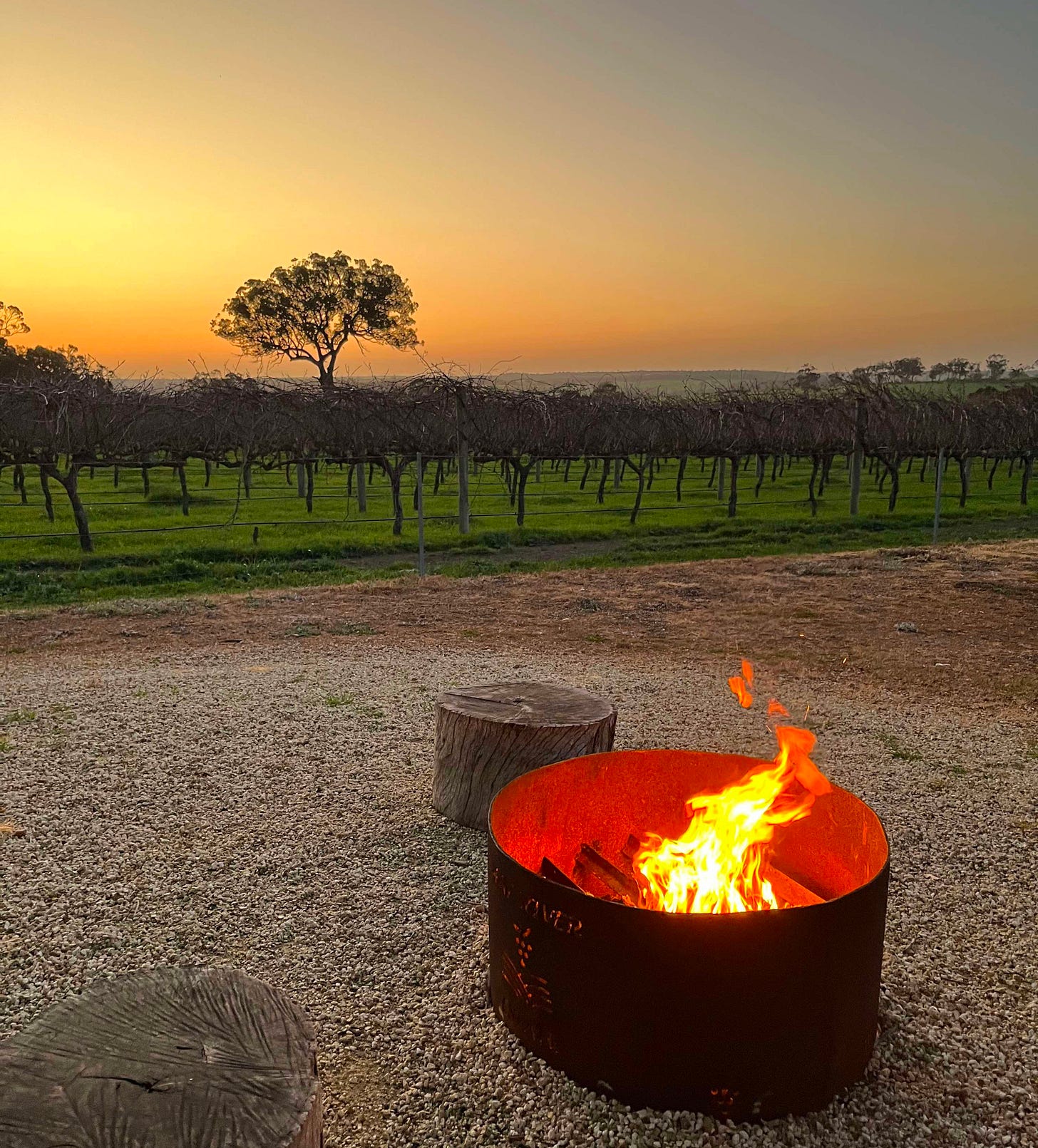
Love this! I found myself yearning for that country that we drove/walked through 15 years ago. Stunning. And beautiful writing x
Your yearning comes through in your words. I wish for you to find that place that embodies what you’re looking for.